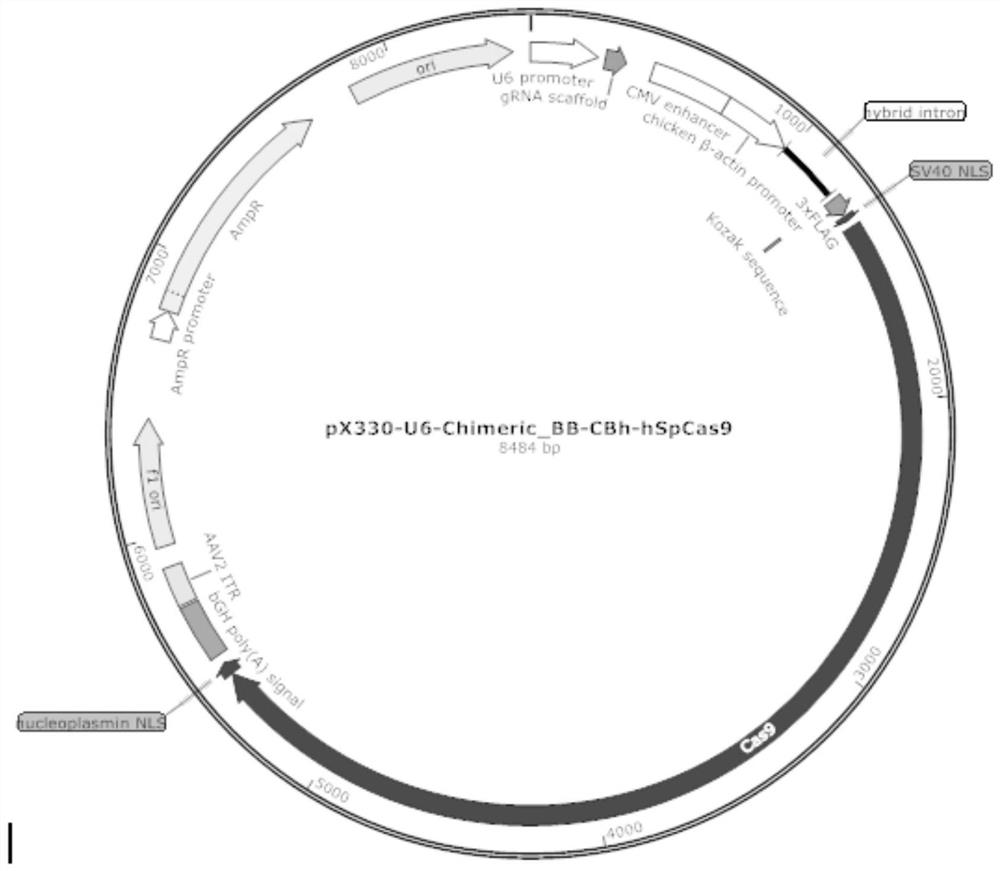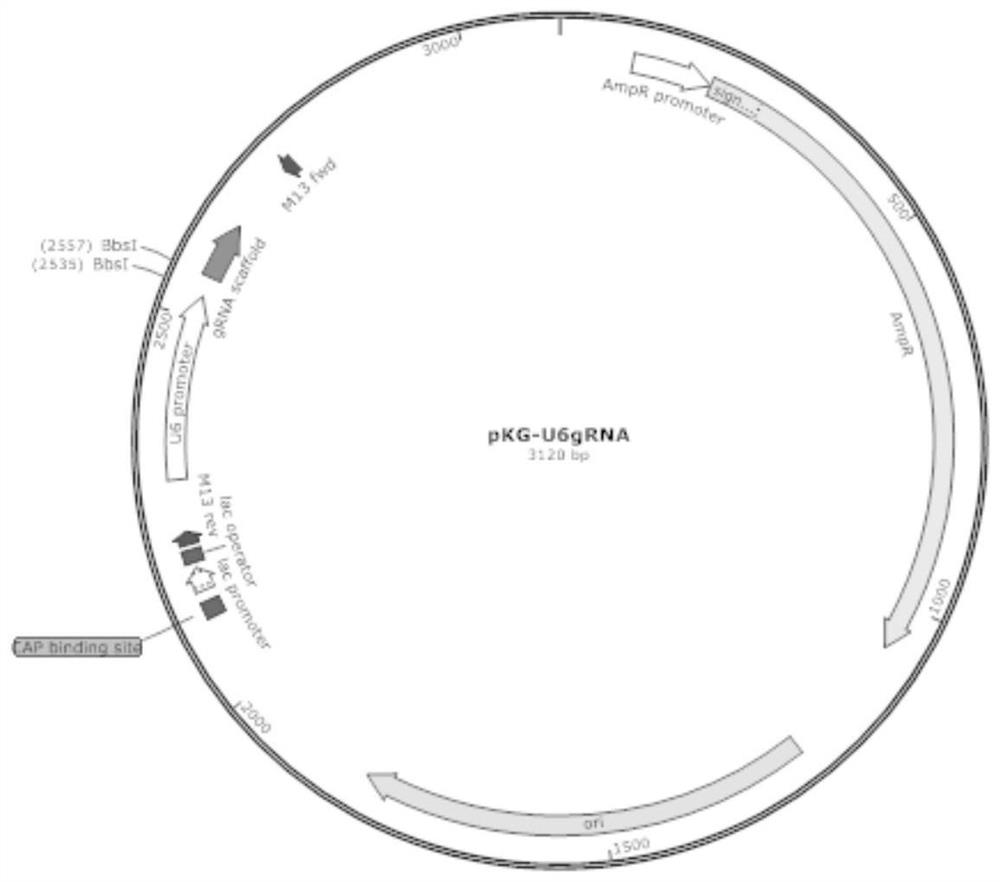CRISPR/Cas9 system and application thereof in construction of swine-derived recombinant cells with insulin receptor substrate gene defects
A technology for recombining cells and genes, applied in the direction of cells modified by introducing foreign genetic material, genetic engineering, recombinant DNA technology, etc. It can solve the problems of small number of individual samples of spontaneous disease animal models and large-scale research.
- Summary
- Abstract
- Description
- Claims
- Application Information
AI Technical Summary
Problems solved by technology
Method used
Image
Examples
Embodiment 1
[0099] Embodiment 1, the preparation of plasmid
[0100] The plasmid pX330-U6-Chimeric_BB-CBh-hSpCas9 was prepared, as shown in SEQ ID NO:1. Plasmid pX330-U6-Chimeric_BB-CBh-hSpCas9, referred to as plasmid pX330.
[0101] The plasmid pU6gRNA eEF1a-mNLS-hSpCas9-EGFP-PURO was prepared, as shown in SEQ ID NO:2. Plasmid pU6gRNA eEF1a-mNLS-hSpCas9-EGFP-PURO, referred to as plasmid pKG-GE3.
[0102] The plasmid pKG-U6gRNA was prepared, as shown in SEQ ID NO:3.
[0103] Plasmid pX330, plasmid pKG-GE3, and plasmid pKG-U6gRNA are all circular plasmids.
[0104] The schematic diagram of the structure of plasmid pX330 is shown in figure 1 . In SEQ ID NO: 1, nucleotides 440-725 constitute the CMV enhancer, nucleotides 727-1208 constitute the chickenβ-actin promoter, and nucleotides 1304-1324 encode the SV40 nuclear localization signal (NLS ), the 1325-5449th nucleotide encodes the Cas9 protein, and the 5450-5497th nucleotide encodes the nucleoplasmin nuclear localization signal (NLS...
Embodiment 2
[0108] Example 2, Screening of Target Combinations for IRS1 Gene Knockout
[0109] 1. IRS1 gene knockout predetermined target and adjacent genome sequence conservation analysis
[0110] Pig IRS1 gene information: codes insulin receptor substrate 1; located on chromosome 15; GeneID is 100512686, Sus scrofa. The protein encoded by the porcine IRS1 gene is shown in SEQ ID NO:4. In the genomic DNA, the porcine IRS1 gene has two exons, the first exon is shown in SEQ ID NO: 6, and the second exon is shown in SEQ ID NO: 7. In the genomic DNA, part of the nucleotides upstream of the first exon of the porcine IRS1 gene is shown in SEQ ID NO:5. The open reading frame of the porcine IRS1 gene is located in the first exon, as shown in nucleotides 1-3726 in SEQ ID NO:6.
[0111] Respectively using the genomic DNA of 8 pigs as a template, using the primer pair composed of primers IRS1-GT-F412 / IRS1-GT-R1220 to carry out PCR amplification, and then perform electrophoresis, see Figure 5 ....
Embodiment 3
[0153] Example 3, Screening of Target Combinations for IRS2 Gene Knockout
[0154] 1. Conservative analysis of exons and adjacent genome sequences of IRS2 gene knockout preset targets
[0155] Pig IRS2 gene information: encoding insulin receptor substrate 2; located on chromosome 11; GeneID is 110255858, Sus scrofa. The protein encoded by the porcine IRS2 gene is shown in SEQ ID NO:11. In genomic DNA, the pig IRS2 gene has 2 exons, the coding region of the first exon is shown in the 1st-4006 nucleotides in SEQ ID NO: 12, and the coding region of the second exon As shown in nucleotides 4007-4011 in SEQ ID NO:12.
[0156] Using the genomic DNA of 8 pigs as a template, PCR amplification was carried out using a primer pair consisting of primers IRS2-GT-nF848 / IRS2-GT-nR1710, followed by electrophoresis, see Figure 8 . The PCR amplification products were recovered and sequenced, and the sequencing results were compared with the IRS2 gene sequence in the public database. Accord...
PUM
 Login to View More
Login to View More Abstract
Description
Claims
Application Information
 Login to View More
Login to View More - R&D Engineer
- R&D Manager
- IP Professional
- Industry Leading Data Capabilities
- Powerful AI technology
- Patent DNA Extraction
Browse by: Latest US Patents, China's latest patents, Technical Efficacy Thesaurus, Application Domain, Technology Topic, Popular Technical Reports.
© 2024 PatSnap. All rights reserved.Legal|Privacy policy|Modern Slavery Act Transparency Statement|Sitemap|About US| Contact US: help@patsnap.com










